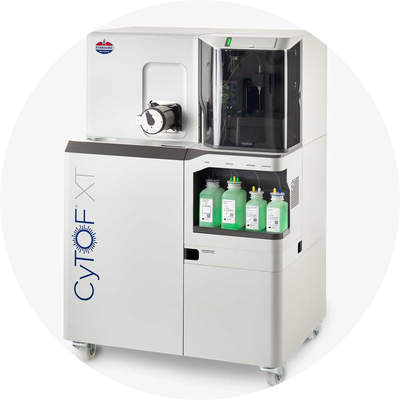A new outlook for CAR T cell therapies
Zinaida Good, PhD, an Instructor in Dr. Crystal Mackall’s laboratory at Stanford University, works at the interface between systems biology and cancer immunotherapy and is focused on investigating why CAR T cell immunotherapies succeed or fail in patients. Her recent work identified certain CAR T cells that interfere with therapeutic efficacy. Continued research into these findings can help better understand the biology of progression following these treatments and how adjustments to CAR therapies might create a more consistent product that can benefit more patients.

Finding biomarkers for toxicity and progression in lymphoma using CyTOF flow cytometry
In an incredible leap forward for chimeric antigen receptor (CAR) T cell therapies, a study out of Stanford University has teased out cell types that interfere with therapeutic efficacy. It is well known that the complexity of the immune system is an obstacle in efforts to develop effective and safe CAR therapies. By analyzing the activity of specific immune cells after treatment, Zinaida Good, PhD, an Instructor in Dr. Crystal Mackall’s laboratory at Stanford University, has found that CAR T regulatory cells link to progression following CD19 CAR therapy for large B cell lymphoma.
These findings represent a new and unexplored axis that can now be further iterated upon to better understand the biology of progression following these treatments, where these CAR T regulatory cells come from and how we can decrease the content of these cells to create a more consistent product that can benefit more patients.
An advantage of CyTOF is that we can look at large numbers of samples and at a moderate cost compared to single-cell sequencing. ”
– Zinaida Good, PhD
Forging a new path to understand and improve on CAR T cell therapies
Working at the interface between systems biology and cancer immunotherapy, Good is focused on investigating why CAR T cell immunotherapies succeed or fail in patients. Her recent work led her to recognize that source material for these therapies is very important. What does that material really contain when taken from a donor and what happens after it is given to a patient?
Typical studies focus on overall CAR T cell expansion, which is linked to clinical outcomes in leukemia. However, in lymphoma this connection is not as strong. Changing the question to look at the kind of CAR T cell expansion, instead of overall CAR T cell expansion, can reveal new paths to response and how therapies can be designed. To do this, Good turned to CyTOF® technology.
“If you use a small-parameter panel, you can only look at the handful of markers that generally identify CAR T cells without the ability to add in other important markers of cell state. CyTOF allows us to include a few different programs that are related to T cell function that, in this case, helped us eventually to arrive at these T regulatory cells. … These weren’t originally in our panel,” Good explains.
Broadening the scope of their standard CAR T cell assay helped her discover CAR T regulatory cells that she found to be significant to therapeutic outcome.
“Interestingly, we didn’t plan to find this population. The data guided us to this answer, and all of this data really made us confident that this population is important.”
This work follows on nicely from Dr. Mackall’s 2005 study published in Nature Medicine showing that chemotherapy treating hematological malignancies can drive expansion of T regulatory cells. However, which patients those cells affect is variable. Next, Good determined to figure out why.
With foundational data on what cell types are present in patients prior to treatment, further immune profiling revealed differences in the starting material of therapies provided to the patients. This is helpful in investigating how and when the T regulatory cells could be expanding. Ongoing work is focused on better understanding the biology and origin of these CAR T regulatory cells and what can be done to address their presence.
Advances in approach lead to expanded questions
Until recently, it was difficult to identify correlates of outcome because there were just not as many samples and not as many tools at hand. Now, with CyTOF flow cytometry, the team can do high-parameter analysis with single-cell sequencing, CyTOF and high-parameter flow cytometry to get more data and more details than they could before.
“An advantage of CyTOF is that we can look at large numbers of samples and at a moderate cost compared to single-cell sequencing. While you can dig deep with the latter technology, you cannot look at every sample because it is prohibitively expensive to do on a massive scale. Since every sample is generally only enough for one assay, learning as much as we can from that one sample is key, so we lean on CyTOF to learn more from each individual sample,” Good says.
Translation of results to improve therapy development and patient outcome
Through this work, Good found that CAR T regulatory cells are associated with lymphoma progression following CAR therapy but also a lower toxicity and CAR T cell expansion. Removal of the regulatory cells could generate a more effective product. Studies into how T regulatory cell removal would alter the cell balance in the therapy inform on possible dosage changes and support the development of a better treatment without increasing toxicity.
“I think if we were able to remove the T regulatory cells from therapies, it would give us a more consistent product,” Good postulates. “Right now, the T regulatory cell fraction is variable, but if we remove these cells, therapy outcomes might actually be more consistent even though the dose perhaps could be slightly less.”
Right now, the T regulatory cell fraction is variable, but if we remove these cells, therapy outcomes might actually be more consistent even though the dose perhaps could be slightly less. ”
– Zinaida Good
Broadening their reach
In conjunction with informing the best course of action for lymphoma patients using CAR T cell therapy, Good also wants to learn more about the biology of the whole process – what is important about these cells and the mechanisms that drive their generation – to better understand the suppressive abilities of these cells at different stages of differentiation.
“We want to understand if this phenomenon is only related to this one type of therapy that we studied, or if it’s happening in other CAR T cell therapies. Is it only relevant to lymphoma?” Good asks. “Perhaps other diseases like leukemias and myelomas can be affected. Essentially, we would like to understand how general this phenomenon is that we found.”
Why CyTOF in 3
CyTOF is a high-dimensional proteomics technology that allows us to broaden the field of view. We can find important cell populations that we didn’t know were there, which is only possible if you have high enough dimensionality of the assay.
Since CyTOF allows us to detect all kinds of proteins, we can use the technology on top of transcriptomics to get different data – it’s well known that RNA and protein are very commonly not correlated. Studying proteins allows a more direct look at a relevant readout to cell function.
The price point of CyTOF is such that we can do large-scale experiments on a large number of samples and it’s not prohibitive, unlike some technologies, which can be prohibitive at scale.


Learn how CyTOF is transforming clinical and translational research.
For Research Use Only. Not for use in diagnostic procedures. Patent and License Information: www.standardbio.com/legal/notices. Trademarks: www.standardbio.com/legal/trademarks. Any other trademarks are the sole property of their respective owners. ©2025 Standard BioTools Inc. All rights reserved.
